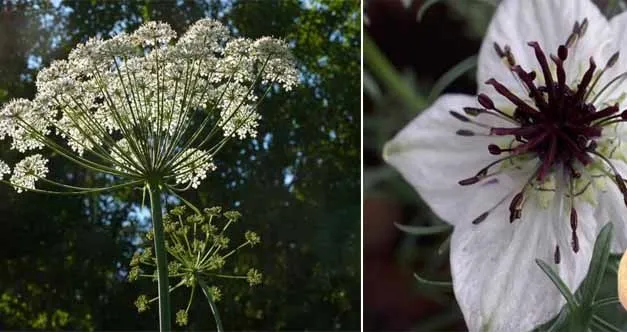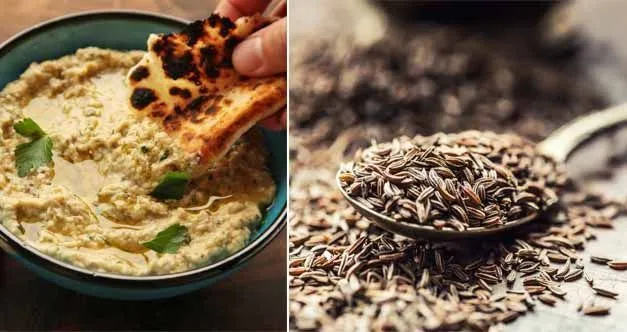It is the turn of the best-known Mediterranean spice, the cumin. A characteristic and pleasant aroma that we can introduce in a multitude of dishes (and we must not associate them with exotic or Asian flavors at all).
We are also going to talk about the properties of cumin which include a very balanced nutritional composition, a multitude of minerals and a high concentration and heterogeneity of vitamins.
Practically, we should consider the consumption of cumin as mandatory, because it is called a superfood.
You will only have to read little by little what we have to tell about the properties of cumin and you will get a surprise, just as we have taken it.
Table of Contents
What is the plant like and what is its origin?

Cumin (whose scientific name is Cuminum cyminum) belongs to the family of apicáeceas.
This family includes a large number of plants with added value for their nutritional and medicinal properties, since they contain different compounds with antimicrobial and antioxidant properties.
Its origin, nothing could be further from the truth, is Mediterranean, so it has always been used regularly in the Mediterranean diet. Currently we can see large tracts of cultivation in America, where it was taken there many years ago.
We can also see it included in many recipes of oriental origin, such as Ras al hanut, Chermoula, curry or Tandoori Masala.
Historically, it has been used both to improve dishes, as a highly sought-after ingredient, or for its medicinal properties. It has been used as a drug (for its soothing properties, as a preservative and even as an antimicrobial when embalming the dead in Egypt.
The cumin seeds they look very similar to rice. They are elongated, golden in color and with a very particular texture.
When we go to the specialized supermarket, we can find different products based on cumin, either with untreated or crushed seeds, to facilitate their use.
As for its flavor, it is a mixture between a very strong aroma and different sweet and bitter colors, as its components penetrate our taste buds.
Properties of cumin
Nutritional characteristics
We have been surprised by the nutritional balance that cumin has, since it is rich in vitamins, minerals and with a fairly balanced composition.
This added to the plant phytochemicals it contains, makes it a medicinal bomb that we can easily include in our diet (we will see it later in the recipes).
Consumption of 100 grams of cumin
| Composition | Quantity |
|---|---|
| Energy | 375 kcal |
| Proteins | 17.8 grams |
| Fats | 22.27 grams |
| Carbohydrates | 44.25 grams |
| Fibre | 10.5 grams |
Vitamin concentration
In addition, among the properties of cumin highlights its high concentration of vitamins, which is not limited to a single one and harbors great heterogeneity.
We can find important values of vitamin B1, vitamin B2, vitamin B6, vitamin E and a long etcetera that you will check below.
This is not always found in other seeds, which usually have peaks of a specific vitamin but absence or value very reduced from others.
Consumption of 100 grams of cumin
| Composition | Concentration | % recommended daily |
|---|---|---|
| Vitamin A | 64 μg | 7% |
| Vitamin B1 | 0.63 mg | 48% |
| Vitamin B2 | 0.33 mg | 22% |
| Vitamin B3 | 4.58 mg | 31% |
| Vitamin B6 | 0.43 mg | 35% |
| Vitamin C | 7.7 mg | 13% |
| Vitamin E | 3.35 mg | 22% |
| Vitamin k | 5.4 μg | 5,0% |
As for minerals The properties of cumin are closely related to its balance and mineral concentration. We make a brief impression of its content among the most important ions for our body.
Consumption of 100 grams of cumin
- Calcium: 930 mg (93% recommended daily allowance)
- Magnesium: 930 mg (252% RECOMMENDED DAILY ALLOWANCE)
- Phosphorus: 500 mg (71% recommended daily allowance)
- Potassium: 1788 mg (38% RECOMMENDED DAILY ALLOWANCE)
- Sodium: 168 mg (11% recommended daily allowance)
- Iron: 66.7 mg (530% recommended daily allowance)
- Manganese: 3330 mg (167% RECOMMENDED DAILY ALLOWANCE)
- Zinc: 4.8 mg (48% recommended daily allowance)
Of the properties of cumin, we are surprised by the high concentration in minerals. While it is true that the intake of 100 grams is very high, in most cases, with 10 grams we even exceed the minimum recommended amount of elements as important as iron or manganese.
As we told you before, cumin has numerous properties that make it a true ally for health.
That is why it has been used with endless purposes within medicine, helping to solve problems of flatulence, abdominal inflammation, poor digestion, muscle spasmsamong others.
Phytochemicals present

One of the most important parts of cumin is its large accumulation in essential oils, polyphenols and terpenes. We found several sources with antimicrobial, digestive activity and a long etcetera.
Cuminaldehyde: antimicrobial and flavoring properties.
Thymol: disinfectant, fungicide and stimulant action of digestion
Pinene: a monoterpenoid with anti-inflammatory, expectorant, antiseptic and bronchodilator properties.
Luteolin: a well-known flavonoid with antioxidant activity, free radical scavenger and inflammation preventive agent.
Apigenin: a class of flavonone with chemopreventive activity and preventive of kidney damage.
1. Helps expel gas and is digestive
It is always known that the main properties of cumin were its effect on digestive improvement after the intake of fats and copious meals. It helps to expel gas and facilitate intestinal transit.
This benefit was used through cumin infusions or desserts with cumin (such as yogurts).
In addition, we must add its high content of essential oils, such as thymol, which promotes intestinal transit, the production of bile and saliva and other enzymes that break down fats and carbohydrates.
These properties of cumin are also activated thanks to a compound found in the plant, the cuminaldehyde.
Cumin contains a number of essential oils such as thymol, which helps promote the production of saliva, bile and other enzymes responsible for the digestion of food. In fact, the aroma of cumin has been shown to stimulate the salivary glands and prepare the body for the digestion process due to the presence of an aromatic compound called cuminaldehyde. In addition to this, cumin is also a great carminative, so it helps relieve the feeling of bloating and gas buildup. It is also ideal if you suffer from hemorrhoids. A couple of tablespoons of cumin will be a great option if you want to make sure you digest food better and avoid annoying stomach pains.
2. It helps us lose weight
There are different spices and ingredients in nature that activate the digestive system, reducing the fixation of fat to our body.
One of them, cumin, is also capable of destroying part of the adipose tissue and intervening in the modulation of fat cells (study obtained in The metabolism Journal).
These properties of cumin to lose weight, always combined with healthy foods and physical activity, also we can find it in cinnamon.
3. Improves oral hygiene
Thymol, commonly present in many plants such as thyme and in a lower concentration in cumin, is frequently used by pharmaceutical companies to produce toothpastes and mouthwashes.
This is due to its disinfectant and antimicrobial action.
The consumption of infusions and the frequent intake of cumin in our meals helps us maintain a strong and healthy mouth without preSencia of microorganisms that cause dental plaque, caries and oral infections.
4. Properties of cumin as an antioxidant potential
Just looking at the vitamin concentration table we see that one of the properties of cumin is based on its antioxidant power.
In addition, it also contains phytosterols and other chemical compounds of plant origin that reduce the activity of free radicals. Today they continue with the research that relates cumin with the prevention of different diseases.
5. Diuretic effect
Among the phytochemicals and flavonoids found in cumin, there are several that stimulate the diuretic effect in our body.
One of them, the Apigenin, is associated with protection against kidney damage caused by many drugs, such as cyclosporine (immunosuppressant commonly used in organ transplants).
6. Has relaxing effect
The infusion of cumin, combined with medicinal plants used for sleep, can come in handy in times of tension or anxiety that prevent us from reconciling the soil. Its intake 30 minutes before sleep induces the floor and regulates disorders related to the nervous system.
7. Controls intestinal parasites
Many of the vegetable essential oils found in this type of plant have antimicrobial and antifungal action.
In the case of cumin, both thymol and thiosemicarbazone of cuminaldehyde reduce the activity of microorganisms and parasites in the intestine, to very low concentrations.
Since ancient times these properties have been attributed to cumin, and it was very frequent to use it when suffering from digestive discomfort, either due to these parasites or poor digestion.
8. Colon Cancer Prevention
The properties of cumin and the effects at different concentrations of its phytochemicals are currently being studied.
Although we can find several of influence in this field, one of them, the luteolin (present in cumin), an important action has been shown in the prevention of different types of cancer, especially colon cancer.
Recipes containing cumin

The properties of cumin are used in a multitude of ancient and modern recipes in practically all civilizations.
In traditional Spanish cuisine, the well-known Mediterranean diet, plays a lot with spices such as pepper and cumin, so we do not have to look for exotic recipes that contain little known spices or little accustomed to many palates.
Its use is basically as a seasoning, providing a pleasant flavor and aroma that combines perfectly with almost all recipes.
It can be used, in small quantities, in sauces and stews (lentils, fabada, chickpeas, etc.), salads, along with other spices, meats and fish.
Other forms of consumption
An unusual but very practical way to take advantage of the properties of cumin it is by infusion.
Its consumption is very practical and can be combined with other medicinal plants also very profitable.
Prepare cumin infusion it is very simple and we are going to tell you how.
- 2 grams cumin seed (whole or crushed)
- 1 cup water (250-300 ml)
Boil the water in the proportions mentioned and add the cumin. Once the water has come to a boil, turn off the heat and let stand for at least 5 minutes. Strain the cumin, in case we have added it whole and it will be ready to take.
It can be combined with cinnamon, peppermint or other plants, consumed with milk, honey or sugar. The possibilities are practically endless.
Buy cumin
Today we have wide access to different forms of consumption of cumin properties.
We can find from the traditional grain to crushed forms to directly prepare infusions like the one we have mentioned.
We leave you some purchase options.
Does cumin have contraindications?
As always, you have to dedicate a small space to talk about possible contraindications and side effects caused by its accumulation in plant phytochemicals.
- It is not advisable to use the cumin essential oil in young children or previously should consult with a pediatrician.
- Avoid its consumption by people allergic to any of the chemical components (thymol, luteolin, pinene, etc.) present in cumin.
- In case of heavy menstruation, you should consult with a specialist doctor, as it can aggravate the problem.
Do you know more properties of cumin? Tell us and we will add it to the article!
